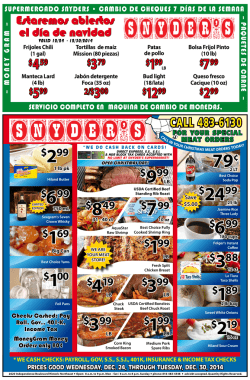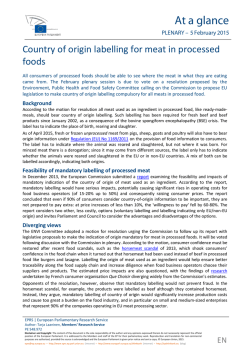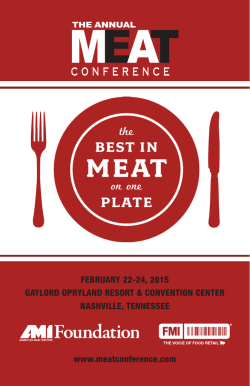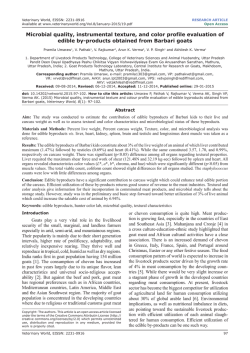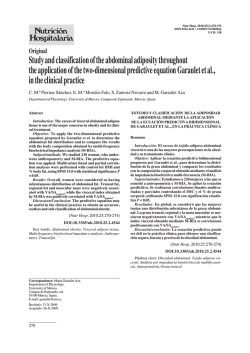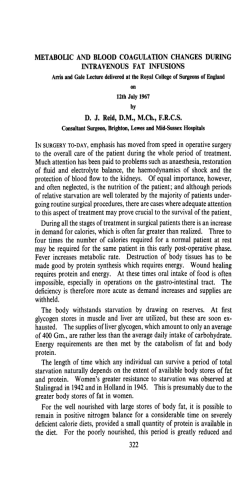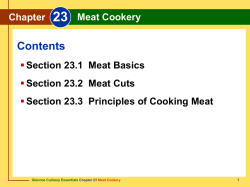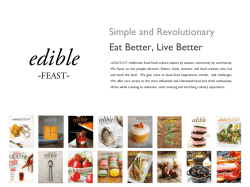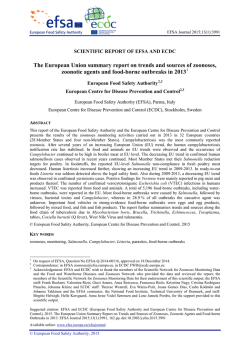
Meat Hygiene Vocabulary
1 Meat Hygiene Vocabulary abattoir An establishment or slaughterhouse where prescribed animals are Buff slaughtered and dressed for the local Bung or bung market. gut aging Controlled meat autolysis prior to freezing, Buttock resulting in a true tenderisation of the meat. Calf bed aitchbone Technically this is the pelvic girdle. More camel hair commonly, the exposed part of the coxae Cancer eye as seen when viewing a side of beef. Ante-mortem The inspection procedure carried out just Cap before the slaughter of food animals. Back fat subcutaneous fat from back of pig Baron of beef twin sirloins undivided Blade bone scapula Bible Trade name for omasum. Blind gut See “cap”. Captive bolt Blood splash Sub-serous haemorrhages, particularly in pistol the diaphragm, abdominal walls, heart and gall bladder. Associated with electrical stunning. Case Bloom The general appearance of a dressed hardening carcase with special reference to its colour. Casings Bobby calf young calf Book omasum Brine A solution of salt (sodium chloride) and water used as a preservative, e.g. in the casings and bacon manufacturing. Cat gut Brocks edible offals Catch bag Brown atrophy Discolouration due to the presence of Caul fat lipochromes in atrophying cells e.g. Chine bones lipofuscinosis in the cheek, tongue and heart of old cattle. Sometimes referred to as “xanthosis”. lungs caecum A cut of meat which extends from the hip joint to the hock. uterus ligamentum nuchae Sqamous cell carcinoma of the third eyelid. Or “blind gut” is the caecum. Sheep’s caecum is used to make condoms, while the serous covering of the ox caecum called “gold beaters threat” is used for surgical sutures and for tennis and squash racket strings. A stunning instrument shaped like a pistol powered by a small explosive charge, which drives a bolt into the brain. The bolt recoils automatically. Is the result of rapid freezing solidifying the outer layers of meat before the internal temperature has had time to fall. Containers for comminuted meat or meat products, e.g. sausages. They may be produced synthetically or from the submucosal connective tissue layers of the intestines – so-called natural casings. See cap. uterus Trade term for omental fat. Trade term for the split vertebral vertebral column, particularly the body and dorsal processes of the thoracic vertebrae. 2 Chitterlings Chopper Chuck steak closed side clynes Cod fat Codex alimentarius Cold chain “cold shortening” Conditioning Large intestines of pigs when cleaned and cooked. Trade term for pigs of either sex that have been used for breeding purposes. The meat is graded “manufacturing”. Choppers are skinned during dressing. A cut of meat taken from beneath the shoulder blade. right side of beef (NB kidney fixed in loin) lymph nodes The scrotal fat of castrated male animals. Internationally agreed food standards and codes of practice for food production. Intended to facilitate international trade and to protect consumers. A series of procedures and systems necessary to keep meat under steady refrigerated conditions through all the stages of cooling, storage and transport. See conditioning. A process that allows full development of rigor mortis of meat before the meat is chilled or frozen, thereby avoiding “cold shortening” and toughness. Which occur when meat is exposed to cold while there is still ATP available to cause contraction (shortening) of the muscle. Contamination The codex alimentarius defines contamination as direct or indirect transmission of objectionable matter to food products. Examples of contamination of meat are: faeces, ingesta, sand, dust, mud, grass, seeds, wool, hair and pus. crow or crown fat Crown crup fat Cure mesenteric fat of pig (mudgeon) Trade term for the colon. omental fat To add salt, brine, sugar, sodium nitrite to meat to improve its taste and keeping qualities. Dark cutting DFD (dark firm dry) meat. Meat quality meat defect resulting from preslaughter depletion of the glycogen reserves resulting in high ultimate pH (>6). Detergent Chemical cleaning agent acting by reducing the surface tension of water. Disinfectant Chemical which destroys pathogenic a.o. micro-organisms. Doug or dugg udder fat of maiden females dredlock unthrifty pig Dripping Rendered edible fat. Compare with lard and tallow. Dry rendering A process by which fat is extracted from animal tissues by heat. Steam and water do not come in contact with the material during this process as they do in wet rendering. Edible Fit for human consumption. Electrical A process which hastens the onset of stimulation rigor mortis. establishment Means any abattoir, exporting packing house, export slaughterhouse or cannery. farthing omasum Fell The thin superficial layer of fascia located immediately beneath the skin. It covers most of the surface of the dressed carcase. “fiery” A carcase in which the capillary beds has 3 carcase FK Freezedehydration Freezer burn Fry Gambrel Game Gammon Geeshead Gelatin not completely drained of blood during bleeding. This often results when the animal is fevered, overexcited or overheated just prior to slaughter. The meat is dark, rigor is weak, pH is high. fresh killed A method of preserving meat, accomplished by freezing followed by heating under vacuum, which removes about 98% of the moisture content. Drying of meat surfaces when the meat is frozen in an atmosphere of low relative humidity. The condition is indicated by a yellowish decolouration and spongy texture of the affected meat. Trade term for a lamb’s liver. A curved metal rod placed between the hind legs of a carcase and inserted where the achilles tendon joins the os calcis. This enables the carcase to be hung by a hook for dressing and freezing. 1. Killed or slaughtered body of any deer, chamois, thar or hare and any pig or goat which has not been herded, mustered or handled in the manner of a farm animal. “Farmed deer” means deer kept in captivity. 2. Game is also the trade name for meat for animals shot in the wild, whereas meat from farmed deer is called “game meat”. Bottom end of side-cured and smoked bacon. genital organs or male urinary organs An extract obtained by boiling bones and glove fat golden slippers gowel greaves Gristle gullet Gut bread Halal Ham hanging side harple bone H-bone HK Heart bread “hobnail liver” Hodge Hogger Honeycomb Hygiene kell kernels lamb’s fry connective tissue. It is soluble in hot water and is used in cooking to set jellies, jams, etc. and as a glue. peritoneal fat pig (leaf) untrodden feet of fetus (bovine) symphysis pubis residue from rendering of pork fat scratching Trade term for cartilage. oesophagus (weasand or wasund) Trade term for the pancreas. A slaughter method based on Islamic religious requirements. Trade name for the cured buttock, hip and thigh meat of pigs. describes left side with floating kidney atlas, 1st cervical vertebra tuber coxae home killed The portion of the thymus (sweet bread) that lies in the thoracic cavity. Common name for a cirrhotic liver. cooked-pig’s stomach A mechanical device (mill) for breaking up bones, fat scraps, condemned carcases, etc. prior to being rendered down. Trade name for the reticulum. A set of principles concerned with the preservation of health and the prevention of disease. omentum (caul) lymph nodes lamb’s testicles leaf leaf seam Lites Iwel lying side Kosher Lard Leaf fat manyplies Marbling Margarine mate Maw Measles Meat Melt “mountain oysters” peritoneal fat - pig (glove fat) peritoneal fat - pig (glove fat) lungs Industrial waste eliminator, used as digestors for animal waste products. This is a wet rendering process. right side with fixed kidney Animals slaughtered by the Jewish method by a Jewish slaughterman. Pure, rendered, edible pig fat used for domestic cooking and in the manufacturing of lubricants, soaps, ointments and some kinds of margarine. Trade name for fat from the peritoneal lining of pigs. omasum Trade term referring to intramuscular fat appearing as streaks of fat in the cut surface of muscle. An emulsion of fat or oil in water, made from vegetable oils, edible tallow or both. sheep and pig mesentery Trade term for the uncooked pig’s stomach. With reference to meat inspection means the presence of parasitic cysts in the musculature of the carcase. The correct term is cysticercosis. 1. The edible part of the muscle of any slaughtered stock …………… 2. Any edible offal taken from slaughtered stock. Trade name for spleen. Trade term for testicles. 4 Mudgeon mesenteric fat of pig - crow or crown fat Neatsfoot oil Oil obtained from the claws or hooves of animals. Used as a light lubricant and for dressing leather. Neckbread The cervical portion of the thymus gland. Compare with “heartbread”. open side left side of beef - raison side oxter where the underside of the leg and flank meet Paddywalk Trade name for the ligamentum nuchae. pare trim off fat Paunch Trade name for rumen. pig’s fry larynx, trachea, lungs, oesophagus, heart and liver, spleen and omentum Pig’s pluck = larynx, trachea, lungs, oesophagus, heart and liver, spleen and omentum pig’s frytop fry less liver Pin bones Common name for the most posterior part of the pelvis. Their anatomical name is tuber ischii. Pluck Trade term for the thoracic viscera removed in dressing, e.g. heart, lungs and trachea. In the pig it includes the liver. Post mortem Examination routinely carried out on all stock slaughtered in New Zealand establishments. psalterium omasum Quality A quality inspection system designed to assurance test product at each stage of production to ensure that standards of quality of the final product are met. Quality control Covers the methods by which assurance plans and strategies are implemented. raice sheep or calf pluck 5 Raison side Rancidity raps Reed Refrigeration Rendering Rennin Rennet rig Rigor mortis rind roll ropes Ruffle fat Runners runt Sanitation “save-all” open side of beef Chemical spoilage of fats and oils by oxidation of unsaturated fats and breaking down of the fats to fatty acids and glycerol by enzymes. small intestines - ropes or runners Trade term for the abomasum. The process of producing low temperatures. Refrigeration is widely used to keep food from spoiling. It is an essential part of the cold chain. A process by which tallow is extracted from animal tissues. The waste from this process is ground to produce meat and bone meal. An enzyme produced by the gastric mucosa of the abomasum. Coagulates milk into digestible solid curds. Commercial name of rennin extracted from bobby calf abomasum (vell). Rennet is used in cheese manufacturing. male pig with one undescended testicle The stiffening of muscles after death. skin of pig oesophagus small intestines - runners Trade term for mesenteric fat. Intestines used to produce casings. small unthrifty pig A set of procedures by which the number of micro-organisms in an environment can be kept below the level at which they become a problem to health. A mechanical device used to separate fat from establishment effluent. Scalding Scragbone scratchings Scudder Scurf “seedy cut” Shank Shelf life Shin bone Side boning “signet-ring tumour” skins Skirt Slink A method of loosening the hairs on pig skins and feathers on poultry skins. A trade term for the first cervical vertebra – the atlas. residue from rendering pork fat - graves An implement used to remove scurf and hair from slaughtered pigs after they are scalded. May be hand operated or mechanical. Flakes from the dead outermost keratinised layer of the epidermis. A trade term for an abnormal condition in pigs characterised by small flecks of melanosis in the subcutaneous fat of the mammary glands. Trade term for the metacarpus and metatarsus. The potential time period a product can be stored under given conditions before it deteriorates in quality sufficiently to make the product unacceptable to the customer. Trade term for the tibia. A method of boning beef. The whole side is boned on a chain system in the boning room, i.e. it is not quartered. Adenocarcinoma of small intestines. intestines Trade name for the diaphragm. The “thick skirt” is the trade name for the pillars of the diaphragm, the “thin skirt” comprises the remainder. 1. Trade name for a cattle foetus, or 2. Dead, newly born lambs. 6 Slipe wool smelt Speckling Springer Stag Sterile stick Suet Sweetbread Tallow target thrapple throat break TK Tripe Veal Wool removed by means of chemicals from the pelts of slaughtered sheep. “Greasy wool” is removed by shearing. spleen Subcutaneous petechial haemorrhages associated with electrical stunning. 1. Trade term for a can which has one end distended by gas. It indicates growth of micro-organisms and hence the product is not sterile. 2. Farmers’ term for an obviously pregnant heifer. male bovine or male pig castrated late The strict definition is an article which is completely free from all micro-organisms and spores. “Commercial sterilisation” is a process aiming at complete freedom from micro-organisms and spores, but there is a probability that some organisms or spores have survived. to bleed Large deposits of fat, especially kidney fat or cod fat, particularly in sheep and cattle. Trade term for the thymus gland (see neckbread, heartbread). Rendered fat. It includes lard and dripping. sheep forequarter less shoulder larynx and trachea thymus town killed Consists of the submucosa and muscular layers of the rumen and reticulum. Tripe is classified as edible offal. Meat from a young bovine animal not more than 12 months old. Bobby veal (white veal) is meat from a bovine animal which throughout its life has been fed only milk, provided the dressed weight does not exceed 100 lbs and the animal is not more than 18 weeks old. Vell The abomosum of a calf that has been fed only milk. Wasund, Trade name for the oesophagus. - gullet Weasand or weasand web ox mesentery Wet rendering Rendering by the injection of steam directly into the material being rendered. willdew pig with mixture of male and female genital organs, i.e. hermaphrodite. Meat any part of a bovine, pig, sheep, goat, horse, ass or mule that is fit for human consumption. Carcass the whole body of one of the above animals that has been slaughtered, after bleeding, evisceration and removal of the extremities of the limbs at the carpus and tarsus, removal of the head and removal of the tail and udder of a cow, and, with the exception of the pigs, removal of the skin. Offal fresh meat other than that of the carcass defined above even if it is naturally attached to the carcass, e.g. kidney. Viscera the offal found in the thoracic, abdominal and pelvic cavities including the trachea and oesophagus. 7 คำที่ใช้ แยกสัตว์ตำ่ งๆ Cattle: Bull Uncastrated male Calf Young of either sex Cow Female, which has given birth to one or more calves Cull cow End of milk production, ready for slaughter, 5-10 years old Heifer or clean Female up to birth of first calf cow Runner or stirk Older calf up to about 16 weeks of age Stag Castrated male (castrated later than 12 weeks old) Steer or bullock Castrated male (castrated between 6 and 12 weeks old) Pigs: Boar Uncastrated male or ‘entire’ male Gilt or clean pig Female up to birth of first piglet Hog Castrated male (castrated between 6 and 8 weeks) Piglet Young of either sex Rig Male with one undescended testicle Sow Female after birth of first litter Stag Castrated male (castrated later in life to facilitate fattening and obviate boar taint) Sheep: Ewe Cast ewe Gimmer Lamb Female that has given birth to one or more lamb Female removed from breeding stock Female up to birth of first lamb Young of either sex from birth to Mutton Sheep Ram or tup Wether or hoggett Poultry: Chicken Broiler Hen Cockerel Capon Poussin Poultry Stag weaning, 3 ½ - 4 ½ months old (see sheep) Lambs not attaining finished condition before weaning, and meat from ewes, hoggets, rams and wethers After weaning; some definitions do not classify lamb as a sheep until the first shear (under this definition a lamb would not be classified as a sheep until approximately 13 months old) Uncastrated male Castrated male sheep (castrated between 3 weeks and 3 months old) Generic term covering several different groups of the same species An American term, now in common use, literally meaning young chicken male or female, that can be broiled, fried and roasted; live weight typical 1.3 kg or more; slaughtered up to 65 days old Female that has laid eggs; spent hens – end of egg laying cycle, some times called boiling fowl Uncastrated male chicken Male chicken that has been castrated Young chicken usually weighing 0.25 – 0.5 kg Also includes turkeys, ducks, geese, guinea fowl, game birds, e.g. pheasant, partridge, pigeon, quail Mature male turkey
© Copyright 2026
